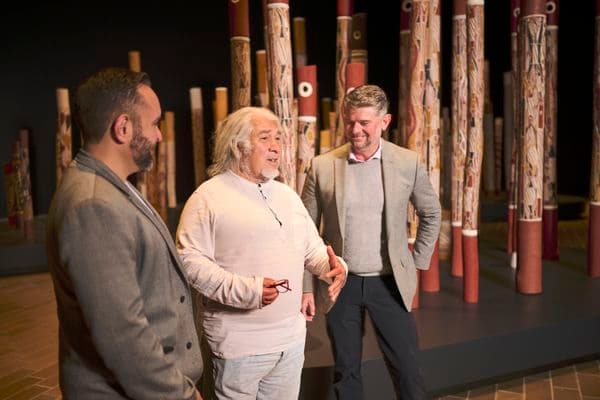Artists & Clans

Ramingining artists, Djon Mundine, Bandjalung people, The Aboriginal Memorial, 1987–88, (detail), purchased with the assistance of funds from National Gallery admission charges and commissioned in 1987

Tony Dhanyula, Buyuyukulmirr people, Tide marks (thin bands), 1987-88, purchased with the assistance of funds from National Gallery admission charges and commissioned in 1987.
Arnhem Land artists are renowned for bark painting; their paintings have been collected by Europeans since the mid-19th century. The Memorial reflects the art traditions of Central Arnhem Land showing a variety of styles, designs and materials.
The different styles are related to the artists' social groups, which link people to a common ancestor, land, language and strict social affilations. All such affiliations play a part in Aboriginal artists' right to paint an established set of designs belonging to their social group; this inheritance is, in fact, the artists' copyright over imagery.
The palette of red, yellow, white and black is created with natural pigments. Ochre is mined locally from quarries and sometimes traded over long distances. Yellow ochre turns red when wrapped in paperbark and put on hot coals. White pigment is kaolin or pipe clay.
The black is generally charcoal, although it is not uncommon for artists to use the carbon from dry cell batteries to achieve a deep black.
Previously, painters employed natural gums and resins such as native orchid juice, tree sap, wax or the yolk of birds' eggs to bind the powdery pigments. The chalky quality apparent on some of the hollow logs in the Memorial is a result of using such natural binders. Since the 1960s however, most artists have favoured commercially available wood glues as a binder, giving a more stable painted surface.
Artists make brushes known as marwat (meaning hair), comprised of several long human hairs connected to a short twig. For intricate work such as cross-hatching, the artist draws the long thin brush away from the body. This cross-hatching, so common to Arnhem Land clan designs, is usually known as rarrk, and is also called miny'tji or dhulang towards the east.



















